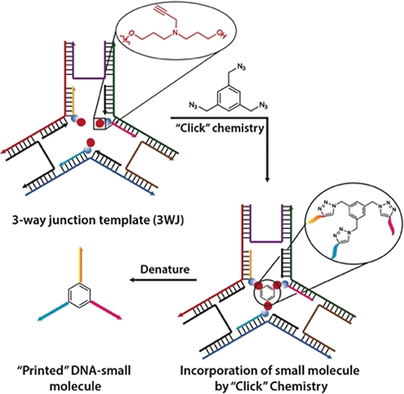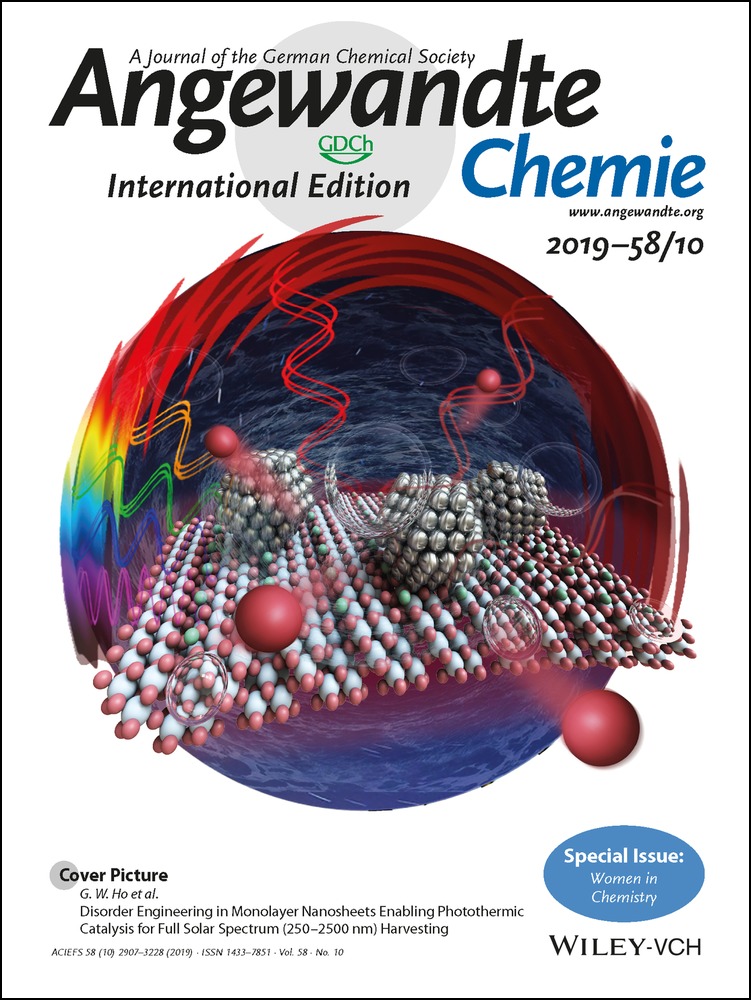“Printing” DNA Strand Patterns on Small Molecules with Control of Valency, Directionality, and Sequence
Tuan Trinh
Department of Chemistry, McGill University, 801 rue Sherbrooke West, Montreal, QC, H3A 0B8 Canada
Search for more papers by this authorDaniel Saliba
Department of Chemistry, McGill University, 801 rue Sherbrooke West, Montreal, QC, H3A 0B8 Canada
Search for more papers by this authorDr. Chenyi Liao
Deparment of Chemistry, The University of Vermont, Burlington, VT, 05405 USA
Search for more papers by this authorDonatien de Rochambeau
Department of Chemistry, McGill University, 801 rue Sherbrooke West, Montreal, QC, H3A 0B8 Canada
Search for more papers by this authorAlexander Lee Prinzen
Department of Chemistry, McGill University, 801 rue Sherbrooke West, Montreal, QC, H3A 0B8 Canada
Search for more papers by this authorProf. Jianing Li
Deparment of Chemistry, The University of Vermont, Burlington, VT, 05405 USA
Search for more papers by this authorCorresponding Author
Prof. Hanadi F. Sleiman
Department of Chemistry, McGill University, 801 rue Sherbrooke West, Montreal, QC, H3A 0B8 Canada
Search for more papers by this authorTuan Trinh
Department of Chemistry, McGill University, 801 rue Sherbrooke West, Montreal, QC, H3A 0B8 Canada
Search for more papers by this authorDaniel Saliba
Department of Chemistry, McGill University, 801 rue Sherbrooke West, Montreal, QC, H3A 0B8 Canada
Search for more papers by this authorDr. Chenyi Liao
Deparment of Chemistry, The University of Vermont, Burlington, VT, 05405 USA
Search for more papers by this authorDonatien de Rochambeau
Department of Chemistry, McGill University, 801 rue Sherbrooke West, Montreal, QC, H3A 0B8 Canada
Search for more papers by this authorAlexander Lee Prinzen
Department of Chemistry, McGill University, 801 rue Sherbrooke West, Montreal, QC, H3A 0B8 Canada
Search for more papers by this authorProf. Jianing Li
Deparment of Chemistry, The University of Vermont, Burlington, VT, 05405 USA
Search for more papers by this authorCorresponding Author
Prof. Hanadi F. Sleiman
Department of Chemistry, McGill University, 801 rue Sherbrooke West, Montreal, QC, H3A 0B8 Canada
Search for more papers by this authorGraphical Abstract
Breaking symmetry: A highly modular method to covalently transfer different DNA sequences with controllable directionality, length, and valency onto different synthetic molecules is reported. These DNA-imprinted small molecules can be elongated asymmetrically to different lengths in high yield using PCR and can be chemically replicated.
Abstract
The incorporation of synthetic molecules as corner units in DNA structures has been of interest over the last two decades. In this work, we present a facile method for generating branched small molecule-DNA hybrids with controllable valency, different sequences, and directionalities (5′–3′) using a “printing” process from a simple 3-way junction structure. We also show that the DNA-imprinted small molecule can be extended asymmetrically using polymerase chain reaction (PCR) and can be replicated chemically. This strategy provides opportunities to achieve new structural motifs in DNA nanotechnology and introduce new functionalities to DNA nanostructures.
Supporting Information
As a service to our authors and readers, this journal provides supporting information supplied by the authors. Such materials are peer reviewed and may be re-organized for online delivery, but are not copy-edited or typeset. Technical support issues arising from supporting information (other than missing files) should be addressed to the authors.
| Filename | Description |
|---|---|
| anie201809251-sup-0001-misc_information.pdf20.7 MB | Supplementary |
Please note: The publisher is not responsible for the content or functionality of any supporting information supplied by the authors. Any queries (other than missing content) should be directed to the corresponding author for the article.
References
- 1
- 1aH. Yan, S. H. Park, G. Finkelstein, J. H. Reif, T. H. LaBean, Science 2003, 301, 1882–1884;
- 1bJ. Sharma, R. Chhabra, A. Cheng, J. Brownell, Y. Liu, H. Yan, Science 2009, 323, 112–116.
- 2
- 2aP. W. K. Rothemund, Nature 2006, 440, 297;
- 2bB. Wei, M. Dai, P. Yin, Nature 2012, 485, 623;
- 2cY. Ke, L. L. Ong, W. M. Shih, P. Yin, Science 2012, 338, 1177–1183;
- 2dE. Winfree, F. Liu, L. A. Wenzler, N. C. Seeman, Nature 1998, 394, 539;
- 2eS. M. Douglas, H. Dietz, T. Liedl, B. Högberg, F. Graf, W. M. Shih, Nature 2009, 459, 414;
- 2fE. Benson, A. Mohammed, J. Gardell, S. Masich, E. Czeizler, P. Orponen, B. Högberg, Nature 2015, 523, 441.
- 3
- 3aA. A. Greschner, V. Toader, H. F. Sleiman, J. Am. Chem. Soc. 2012, 134, 14382–14389;
- 3bC. K. McLaughlin, G. D. Hamblin, H. F. Sleiman, Chem. Soc. Rev. 2011, 40, 5647–5656;
- 3cJ. Zimmermann, M. P. J. Cebulla, S. Mönninghoff, G. v. Kiedrowski, Angew. Chem. Int. Ed. 2008, 47, 3626–3630; Angew. Chem. 2008, 120, 3682–3686;
- 3dK. V. Gothelf, R. S. Brown, Chem. Eur. J. 2005, 11, 1062–1069.
- 4
- 4aI. Eryazici, T. R. Prytkova, G. C. Schatz, S. T. Nguyen, J. Am. Chem. Soc. 2010, 132, 17068–17070;
- 4bF. A. Aldaye, H. F. Sleiman, J. Am. Chem. Soc. 2007, 129, 13376–13377;
- 4cM. Endo, N. C. Seeman, T. Majima, Angew. Chem. Int. Ed. 2005, 44, 6074–6077; Angew. Chem. 2005, 117, 6228–6231;
- 4dA. A. Greschner, K. E. Bujold, H. F. Sleiman, J. Am. Chem. Soc. 2013, 135, 11283–11288;
- 4eI. Eryazici, I. Yildirim, G. C. Schatz, S. T. Nguyen, J. Am. Chem. Soc. 2012, 134, 7450–7458.
- 5N. C. Seeman, H. F. Sleiman, Nat. Rev. Mater. 2017, 3, 17068.
- 6H. Yang, C. K. McLaughlin, F. A. Aldaye, G. D. Hamblin, A. Z. Rys, I. Rouiller, H. F. Sleiman, Nat. Chem. 2009, 1, 390.
- 7M. R. Hartman, D. Yang, T. N. N. Tran, K. Lee, J. S. Kahn, P. Kiatwuthinon, K. G. Yancey, O. Trotsenko, S. Minko, D. Luo, Angew. Chem. Int. Ed. 2013, 52, 8699–8702; Angew. Chem. 2013, 125, 8861–8864.
- 8B. J. Hong, I. Eryazici, R. Bleher, R. V. Thaner, C. A. Mirkin, S. T. Nguyen, J. Am. Chem. Soc. 2015, 137, 8184–8191.
- 9
- 9aH. A. Becerril, R. M. Stoltenberg, D. R. Wheeler, R. C. Davis, J. N. Harb, A. T. Woolley, J. Am. Chem. Soc. 2005, 127, 2828–2829;
- 9bS. Rudiuk, A. Venancio-Marques, G. Hallais, D. Baigl, Soft Matter 2013, 9, 9146–9152.
- 10
- 10aP. Richa, M. Andreas, Chem. Asian J. 2011, 6, 1450–1455;
- 10bH. Bußkamp, S. Keller, M. Robotta, M. Drescher, A. Marx, Beilstein J. Org. Chem. 2014, 10, 1037–1046.
- 11
- 11aM. Meng, C. Ahlborn, M. Bauer, O. Plietzsch, S. A. Soomro, A. Singh, T. Muller, W. Wenzel, S. Brase, C. Richert, ChemBioChem 2009, 10, 1335–1339;
- 11bA. Singh, M. Tolev, M. Meng, K. Klenin, O. Plietzsch, C. I. Schilling, T. Muller, M. Nieger, S. Bräse, W. Wenzel, C. Richert, Angew. Chem. Int. Ed. 2011, 50, 3227–3231; Angew. Chem. 2011, 123, 3285–3289.
- 12
- 12aA. I. Ponomarenko, V. A. Brylev, K. A. Sapozhnikova, A. V. Ustinov, I. A. Prokhorenko, T. S. Zatsepin, V. A. Korshun, Tetrahedron 2016, 72, 2386–2391;
- 12bG. Clavé, G. Chatelain, A. Filoramo, D. Gasparutto, C. Saint-Pierre, E. Le Cam, O. Piétrement, V. Guérineau, S. Campidelli, Org. Biomol. Chem. 2014, 12, 2778–2783.
- 13R. V. Thaner, I. Eryazici, O. K. Farha, C. A. Mirkin, S. T. Nguyen, Chem. Sci. 2014, 5, 1091–1096.
- 14K. D. Okochi, L. Monfregola, S. M. Dickerson, R. McCaffrey, D. W. Domaille, C. Yu, G. R. Hafenstine, Y. Jin, J. N. Cha, R. D. Kuchta, M. Caruthers, W. Zhang, J. Org. Chem. 2017, 82, 10803–10811.
- 15
- 15aM. Endo, H. Sugiyama, ChemBioChem 2009, 10, 2420–2443;
- 15bK. V. Gothelf, A. Thomsen, M. Nielsen, E. Cló, R. S. Brown, J. Am. Chem. Soc. 2004, 126, 1044–1046;
- 15cC. Panagiotidis, S. Kath-Schorr, G. v. Kiedrowski, ChemBioChem 2016, 17, 254–259;
- 15dE. Utagawa, A. Ohkubo, M. Sekine, K. Seio, J. Org. Chem. 2007, 72, 8259–8266.
- 16L. H. Eckardt, K. Naumann, W. M. Pankau, M. Rein, M. Schweitzer, N. Windhab, G. von Kiedrowski, Nature 2002, 420, 286.
- 17
- 17aT. Trinh, C. Liao, V. Toader, M. Barłóg, H. S. Bazzi, J. Li, H. F. Sleiman, Nat. Chem. 2018, 10, 184;
- 17bT. G. W. Edwardson, K. L. Lau, D. Bousmail, C. J. Serpell, H. F. Sleiman, Nat. Chem. 2016, 8, 162.
- 18
- 18aX. Li, D. R. Liu, Angew. Chem. Int. Ed. 2004, 43, 4848–4870; Angew. Chem. 2004, 116, 4956–4979;
- 18bT. Trinh, P. Chidchob, H. S. Bazzi, H. F. Sleiman, Chem. Commun. 2016, 52, 10914–10917.
- 19Y. He, T. Ye, M. Su, C. Zhang, A. E. Ribbe, W. Jiang, C. Mao, Nature 2008, 452, 198.
- 20
- 20aG. D. Hamblin, J. F. Rahbani, H. F. Sleiman, Nat. Commun. 2015, 6, 7065;
- 20bK. L. Lau, H. F. Sleiman, ACS Nano 2016, 10, 6542–6551.
- 21
- 21aJ. K. Lee, Y. H. Jung, J. B. H. Tok, Z. Bao, ACS Nano 2011, 5, 2067–2074;
- 21bJ. K. Lee, Y. H. Jung, R. M. Stoltenberg, J. B. H. Tok, Z. Bao, J. Am. Chem. Soc. 2008, 130, 12854–12855;
- 21cJ. K. Lee, F. Jäckel, W. E. Moerner, Z. Bao, Small 2009, 5, 2418–2423.
- 22
- 22aT. Wang, R. Sha, R. Dreyfus, M. E. Leunissen, C. Maass, D. J. Pine, P. M. Chaikin, N. C. Seeman, Nature 2011, 478, 225;
- 22bX. He, R. Sha, R. Zhuo, Y. Mi, P. M. Chaikin, N. C. Seeman, Nat. Mater. 2017, 16, 993.
- 23G. von Kiedrowski, L. H. Eckardt, K. Naumann, W. M. Pankau, M. Reimold, M. Rein, Pure Appl. Chem. 2003, 75, 609.





